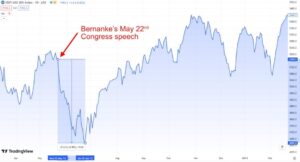Understanding the global market dynamics is crucial for ASX investors because foreign economies and stock markets have a significant impact on Australian stocks. Despite Australia’s share market representing only about 2% of the global market, many ASX companies are directly influenced by global market performance due to their international operations, reliance on commodity prices, and involvement in international trade.
This week, we delve into how events in other economies affect the ASX.
The US Market:
The US market, being the world’s largest economy and financial market, exerts a substantial influence on the ASX. The decisions made by the US Federal Reserve regarding interest rates can significantly sway global investment flows. For example, the “taper tantrum” of 2013 occurred when the then-Fed chief, Ben Bernanke, announced plans to reduce bond purchases, leading to a spike in bond yields. This resulted in capital flowing into the US and a withdrawal of capital from riskier overseas markets, including Australia, causing the ASX 200 to plummet by almost 10% in the following month.

Additionally, the overnight performance of the Dow Jones Industrial Average and S&P 500 often sets the trading tone for the ASX, given the US market’s global benchmark status.
The Chinese Market:
The Chinese market also plays a significant role in ASX dynamics as China is Australia’s largest trading partner. The economic health of China, particularly in relation to commodity demand, directly impacts resource-heavy ASX companies.
Interrelation of Commodity and Stock Markets:
Moreover, there is a strong interrelation between global commodity prices and the ASX due to the ASX’s substantial concentration of resource-oriented companies. The Basic Materials sector, which comprises 24% of the ASX’s market weight, second only to the Financial Services sector at 26.2%, highlights the importance of commodities in the ASX’s composition. In comparison, the Information Technology sector represents approximately 28.1% of the S&P 500’s weight.
Currency Exchange Rates:
Currency exchange rates are critical drivers of global financial health and also have an influence on the ASX. For example, during the mining boom from 2003 to 2011, the Australian dollar appreciated by 81% against the US dollar, resulting in increased profitability for ASX-listed exporters as their revenue in US dollars became more valuable in Australian terms. Conversely, a stronger Australian dollar can benefit companies heavily reliant on imported goods by reducing their cost of goods sold.
